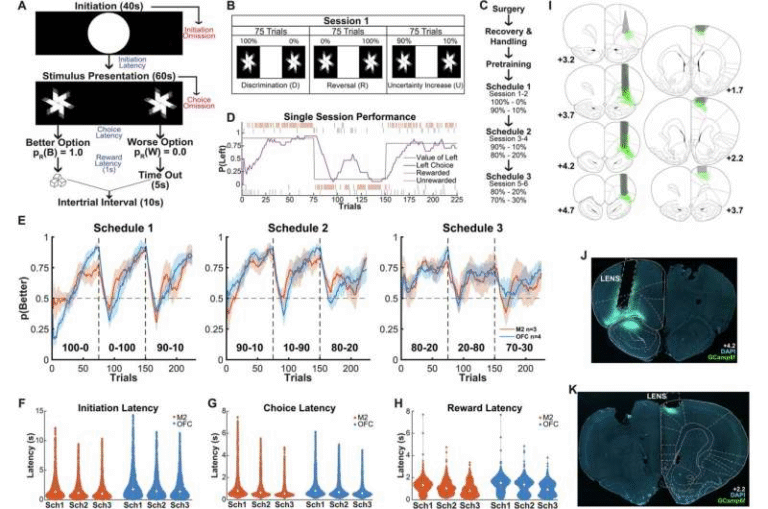Monitoring Stress from the Surface of the Body: How Wearables Are Helping Scientists Understand Anxiety
Researchers at the University of Illinois Urbana-Champaign’s Carle Illinois College of Medicine are exploring how the human body responds to stress — not just through behavior or self-reports, but by directly measuring what happens under the skin. Their lab, part of the Department of Biomedical and Translational Sciences, is turning cutting-edge wearable devices into tools for understanding and managing stress and anxiety in everyday life.
Their setup looks more like a futuristic engineering lab than a psychology space. Tables are covered with wires, sensors, and a bucket of ice water, waiting to trigger stress responses as part of controlled experiments. The aim is clear: to measure how the brain and body react to stress, and to design wearable systems that can one day detect and even predict anxiety in real time.
How the Study Works
The researchers use a range of wearable sensors to capture signals from the brain, heart, muscles, and skin. When a participant walks into the lab, the team starts by placing a cap embedded with 64 electrodes on their scalp. These electrodes detect electrical activity in the brain, known as EEG signals, and each connection is checked carefully until the system shows clear signals — indicated by green lights on the monitor.
Next comes a smart shirt, wrapped snugly around the participant’s torso. This shirt tracks heart rate, breathing patterns, and body movement through tiny embedded sensors. A wristband is fitted on the nondominant hand to record electrodermal activity, skin temperature, and blood volume per pulse. To complete the setup, electromyography (EMG) sensors are attached to the neck, shoulders, arm, and torso to measure muscle tension.
By the time the participant is ready, they are connected to multiple devices but can still move freely. These wearables collect detailed physiological data that reveal how stress affects different body systems — all at once.
The Stress Tests
Before the tests begin, participants are guided through a five-minute meditation to help them return to a calm baseline. Then the real challenges start.
The Cold Pressor Test
This involves immersing one hand in ice-cold water for up to one minute. While simple on paper, it quickly exposes each participant’s pain threshold and physiological response to discomfort. Some participants handle it calmly, while others withdraw their hand within seconds. Sensors record heart rate spikes, changes in skin conductance, and muscle tension, showing how the body reacts to physical stress.
The Trier Social Stress Test
Next is a social and cognitive challenge known as the Trier Social Stress Test, which reliably triggers anxiety in laboratory settings. The participant is told — often with little warning — that they must give a three-minute speech and then solve a mental arithmetic task while being observed by researchers through a camera.
The researchers maintain neutral expressions throughout, offering no encouragement or feedback. For many, this silence is the hardest part. Their cortisol levels — the primary stress hormone — rise noticeably, and physiological readings show spikes in heart rate and electrodermal activity. Some participants deliver their speeches confidently; others stumble, fall silent, or tremble slightly. The wearable data captures every reaction in real time.
The Stroop Test
The final task, known as the Stroop Test, introduces cognitive interference. Participants see color words (like “red,” “blue,” “green”) printed in either matching or mismatched colors and must quickly name the color of the text — not the word itself. This test is performed both seated and while walking on a treadmill, adding movement-related complexity.
Even though it sounds simple, doing it under time pressure while wired to sensors can raise stress levels significantly. The walking version, in particular, simulates real-world multitasking and provides rich data on how anxiety interacts with motion and attention.
After the Experiment
Once all tests are completed, participants are debriefed and given time to relax. The research team saves all the collected data and then sends each participant home with a wearable kit designed to track their physiological signals during daily life.
This combination of controlled lab data and real-world monitoring helps researchers understand how stress manifests differently across situations. It also allows them to compare each person’s lab responses to what happens in their day-to-day routines.
What the Researchers Have Achieved So Far
The Carle Illinois team has already developed data analysis tools capable of interpreting signals from the smart shirts and wristbands. One of their recent models can predict individuals at higher or lower risk of heart-related issues based on exercise data from these wearables.
More recently, the group has built machine learning models that can detect anxiety using multimodal physiological data — even when the system hasn’t been trained on that individual before. In other words, these systems can recognize patterns of stress without prior calibration, opening the door for generalized anxiety detection through wearable devices.
Their goal is to make diagnosis and monitoring of anxiety more accessible and affordable. Instead of relying on psychological evaluations alone, they aim to measure objective physiological responses, making stress assessment more consistent and continuous.
Why This Research Matters
Understanding stress through wearable sensors isn’t just an academic pursuit — it’s a practical step toward personalized mental health care. Anxiety and chronic stress are among the most common mental health challenges worldwide, affecting physical health, concentration, and quality of life.
By analyzing physiological data such as heart rate variability, electrodermal activity, and muscle activation, scientists can track how the body reacts to both physical and emotional challenges. This could lead to early warning systems that notify individuals when their stress levels rise beyond healthy limits — a sort of “stress thermometer” for the mind and body.
Imagine wearable devices that don’t just count steps or calories but can tell when you’re approaching burnout, alerting you to take a break or use relaxation techniques. The research at the University of Illinois moves science one step closer to that vision.
The Science Behind Stress Monitoring
When a person experiences stress, the body triggers a chain reaction involving the autonomic nervous system. The sympathetic branch activates, increasing heart rate, blood pressure, and skin conductivity, while the parasympathetic branch works to restore balance afterward.
Wearable sensors — such as ECG monitors, EDA wristbands, and respiration trackers — can capture these subtle changes. Combined with algorithms that analyze patterns over time, they can help identify stress signatures unique to each individual.
This kind of continuous, data-driven insight could eventually support mental health treatments, workplace wellness programs, and even stress management in high-risk professions like healthcare, aviation, and emergency response.
Looking Ahead
The University of Illinois researchers are now working to refine their machine learning models and test their systems in more diverse, real-world settings. They also aim to develop predictive models that can anticipate anxiety episodes before they occur — allowing users to intervene early.
By bridging engineering, neuroscience, and medicine, this team is helping to redefine how we understand and manage stress. As wearable technology continues to evolve, so too will our ability to monitor and care for the mind through the body’s signals.
Research Reference:
Alkurdi, A., He, M., Hernandez, M. et al. “Extending Anxiety Detection from Multimodal Wearables in Controlled Conditions to Real-World Environments,” Sensors (2025).






